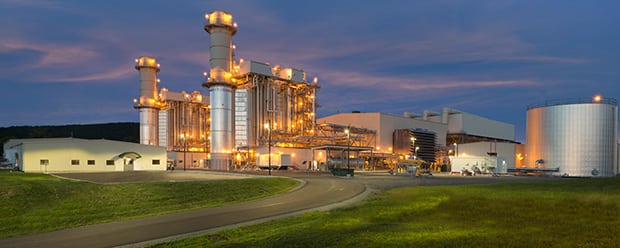In recent years, the use of single-shaft combined cycle power plants has steadily increased in the U.S. While multi-shaft configurations are advantageous in certain scenarios—for example, when layout flexibility or phased installation is needed—single-shaft designs have proven to be a highly efficient and cost-saving option for power plant owners and operators seeking to maximize the value of their asset.
Single-Shaft vs. 1 x 1 Multi-Shaft
In a single-shaft configuration, both prime movers (the gas and steam turbines) are on one shaft line connected by a synchronous self-shifting (SSS) clutch, and they drive a single, common generator (Figure 1). Beyond a common generator, the balance of plant (BOP) systems in a single-shaft configuration are also harmonized resulting in fewer individual components. This is in contrast to multi-shaft configurations, where the steam and gas turbines are on different shaft lines, supported by separate BOP systems, and drive their own independent generators.
Having a single generator connected to the grid and less BOP equipment offers financial, operational, and footprint advantages for the single-shaft arrangement. For instance, one generator means one set of bus ducts, and one generator breaker, generator step-up transformer, and switchyard. In many cases, choosing a single-shaft arrangement rather than a multi-shaft design can result in capital expense savings of 3% to 5% for the plant.
A small gain in plant efficiency can also be achieved, as one large generator typically has a slightly higher efficiency than two smaller ones. Single-shaft configurations also require fewer mechanical connections, which translates into lower losses. Similarly, the simplification of BOP systems, such as lube oil systems, can result in less maintenance, higher availability, and lower auxiliary power demand. Single-shaft configurations have a more compact design than multi-shaft, leading to a smaller footprint for the plant. This is especially advantageous on sites where equipment needs to be enclosed within a building, due to noise or weather restrictions, for example.
Multi-shaft configurations are preferred for meeting specific arrangement requirements or when the gas turbine is constructed and operated months or years ahead of combined cycle development.
2 x Single-Shaft vs. 2 x 1 Multi-Shaft
Two single-shaft plants can also be utilized as an alternative to traditional 2 x 1 configurations. With one steam turbine for each gas turbine, the single-shafts can exhibit higher efficiency in low-load scenarios (that is, when only one gas turbine is in operation). This is also the case when switching from one to two gas turbine operation. In such cases, each heat recovery steam generator (HRSG) produces steam for its own steam turbine. As a result, there is no need to bring up the second HRSG in bypass operation to match steam temperature and pressure before blending with the steam going to the turbine from the first HRSG.
An added benefit of the 2 x single-shaft design is that it allows for phased combined cycle construction of trains during the installation phase of the power plant. Having two combined cycle blocks, each with a single-shaft power train, also provides advantages with regards to availability and maintenance, as it allows for the servicing of one train while the other is in operation. In certain cases, this will enable power plant operators to more effectively respond to the needs of the market. Conversely, service on any component besides a gas turbine in a 2 x 1 configuration requires the entire plant to be out of operation.
The same benefits mentioned for a 1 x 1 multi-shaft plant apply for a 2 x 1 plant—layout flexibility and phased construction of simple cycle gas turbines.
Real-World Benefits
The benefits of using a single-shaft design for combined cycle operation have been on display at various sites globally, including the recent Panda Liberty site (Figure 2) in Bradford County, Pennsylvania, and Panda Patriot site in Lycoming County, Pennsylvania. Both were commissioned in 2016 and designed to utilize Marcellus shale gas to power their communities in the most-efficient manner. The plants each feature two single-shaft power blocks with Siemens H-class gas turbines.
Having two combined cycle blocks, each with a single-shaft power train provides the Panda plants with a high degree of operational flexibility, as they can run at 50% plant load while maintaining the same efficiency as 100% plant load. An SSS clutch allows the gas turbine to start-up and produce electricity quickly, independently of the steam turbine. When the steam turbine reaches synchronization speed, the SSS clutch is engaged and transfers the steam turbine’s torque to the generator so the plant can reach full load.
Siemens is continuing to expand the boundaries of output and efficiency with the latest SCC-9000HL single-shaft combined cycle design. Building off of proven H-class technology, the 9000HL-class provides an efficiency of up to 63% in combined cycle operation and 25% higher power output. The SCC-9000HL utilizes trusted and validated design concepts allowing for combined cycle operation in both single- or multi-shaft configurations.
Weighing the Options
With extensive experience designing and constructing combined cycle power plants across the globe, Siemens can offer several objective cases for both single-shaft and multi-shaft configurations, as well as innovative approaches to maximize the benefits of both. While single-shaft designs provide benefits with regard to footprint, availability, and efficiency, the decision is not a simple “one-design-fits-all” matter, as multi-shaft configurations offer distinct benefits as well, particularly on projects where layout flexibility and phased construction are required. Ultimately, the configuration that delivers the most value over the life of the power plant will be dictated by operator and load requirements, and site-specific variables.
—Jennifer Jackson is solutions portfolio marketing manager with Siemens.
https://www.powermag.com/benefits-of-single-shaft-combined-cycle-power-plants/

